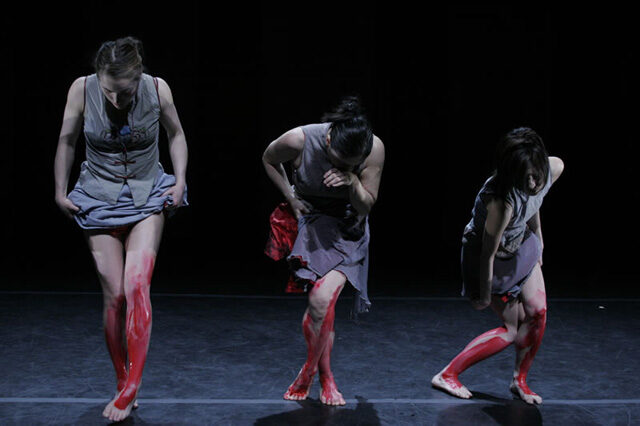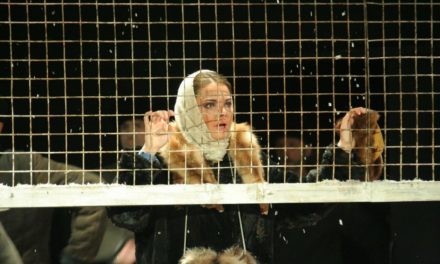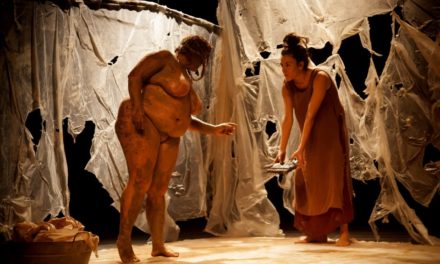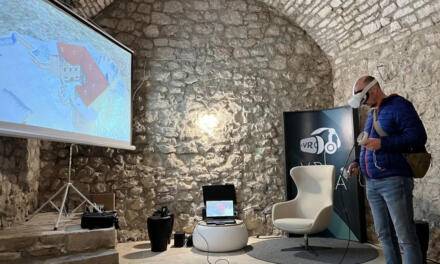Chris Salter is an artist and theoretician based in Montreal, Canada. In his artistic work, he creates multisensorial environments that regularly challenge our senses, especially our haptic and gustatory senses. In March he held a workshop at the Media Design Department of Moholy-Nagy University of Art and Design Budapest, and on this occasion, we sat down to talk a bit about what immersion actually is its aesthetics and our craving for experiences.
How did you find your path between theatre and technology?
A theatre is a big machine, it has its technological apparatus from the Greeks, through the Nō theatre, the Renaissance, Constructivism, the 1960s avant-garde, and Broadway – it is a big machine. El Lissitzky designed a stage for the Russian avant-garde director Meyerhold in the mid-1920s, where he wanted to eliminate the distinction between the audience and the stage. This is an old story, it didn’t start with the interactivity in computing. I’ve always been interested in the relationship between stage and technology. I studied computer music and theatre at Stanford University. I also worked in Germany in the 1990s having researched how new kind of “Gesamtkunstwerks” total artworks) were built in the context of the German theatre. Because of this and because his work was so mind-blowing for me at the time, I was eventually drawn to working with William Forsythe who was already dealing with this mix between technology and visceral physical performance at the Frankfurt Ballet. At the time, he was very interested in computer-based interaction systems. The theatre thus was always a way to explore broader questions I had about architecture, about framing a space, about various types of temporal experiences and the questions of the machine and human interaction and connection. Later I moved away from the traditional stage because the new media scene and the questions it was asking seemed much more interesting than the psychologism of the theater.
Why do we want to have more immersive experiences now?
For me, immersion is not about the surround which has long been seen as an art historical concept that includes panoramas and all of the apparatuses of cinema. To me, immersion is losing a sense of the distinction between the body and the environment or between the self and the non-self. It’s natural that advanced technological transformations happened at the end of the XIXth century as there were the first notions of immersion in the media starting with the panorama and later, they were propagated by the film, which was “the” art form. Now we have other art forms to deal with: computing and all of its ancillary offshoots. The other reason that immersion is big now is that capitalism needs it. If you read Susan Buck-Morss’ writing on Walter Benjamin’s essay “Artwork in the Age of Mechanical Reproduction”, you’ll find that perception, technology, and history are never separated. Each epistemic shift brings about new forms of perception along with new forms of technological understanding.
Right now there is also an obsession with immersion. For example, Thomas Oberender (intendant of Berliner Festspiele) considers immersion as a way of getting away from the form of the theatre. He looks more to the form of new types of contexts or environments being generated between the performing and the visual arts, because our entire environment is increasingly recognized as technical. People are interested in what is their body’s role and what kind of experiences are made possible by the shifting technological and sociopolitical epistemes that arise. Of course, as VR headsets are getting cheaper, everyone calls this immersive as well.
Do you think we are at the right stage of development to find suitable content for these technologies?
This is the industry’s idea: “Oh, we make a tool then someone will make content for it”. I have a problem with the paradigm of VR: there’s a difference between walking 20 meters in a room and walking 5 meters in a VR space. Perceptually we are tuned to a different understanding of space. You can create a simulation but it’s still just a simulation. There’s a difference between a simulation and an actual proprioceptive experience in a room. But related to social VR: you can’t critique the question of presence anymore because that is now the lingua franca of VR. Everything is about presence. In the 1980s it was all about absence: it was about getting rid of the body, simulating it and dissolving into the technical ether. The language of an embodiment has caught up with VR too. It’s not about the technology, it’s about what Latour says: how does it mediate the social fabric or the social-political fabric.
With open systems, it’s different because they can actually modulate and change according to their environment. But I haven’t seen VR work that I could find very interesting. My students did already…
Do you think we can really let go of the control of our sense or our responses to the senses? Are we ready for it?
It happens with drugs. Don’t forget our senses are culturally formed and socially formed. So to go beyond senses, we have to go beyond our cultural assumptions.
Are we ready to give away our agency?
People jump out of airplanes and go under the sea. We put our body in these extreme situations all the time. Why should art be any different? What’s the difference between a club and going to a museum. You could say there is art and entertainment but that’s a very European-centric idea. We make all these separations between things, but we’re already immersed in the world. It’s a classical phenomenological argument: there’s no external world, we’re in the world; we’re thrown into the world and we have to deal with it, so why should art be any different?
What do you think about the concept that “experiences are becoming an artistic medium”?
If go to the historical notion of aesthetics from the 19th century, from Baumgarten “What is the aesthetic”: the aesthetic is not the Kantian distance that we take, but it’s our direct sense perception of a physical, material world: understanding of being a material being in the world. In the 1960s art historians started to realize that there’s no longer an object at all, so art historians started seeing objecthood as being an issue. The idea that artwork is separated from experience is in eclipse. Despite the fact that, of course, artwork in the market sells objects. This idea that artwork is not about the experience is a really old idea.
The battle in art history of the end of the 1950s up until relational aesthetics in the nineties was all about what constitutes the object of experience or the object of performance; how to objectify that which cannot be objectified. But ironically, the unchanging Clement Greenbergian kind of self-sufficient truth of the art object was already blown up by Duchamp – way before the 1960s. Art is really a state of mind.
Talking about objecthood and environment. What is your stance on narrative spaces?
I’m totally uninterested in the narrative.
Why?
Because I think stories are going to emerge from your own experience of certain kinds of spaces. I don’t want to impose my narrative. I don’t like reading fiction, I like stories that are more non-representational. I mean, it’s not that narratives aren’t important but there are other people doing it better. You can also create experiences for people that are totally nonlinear, that have no structure and people stay in for hours. The world is not creating a narrative for you. And yet there’s meaning: you produce your own meaning. Brian Eno quoting the art historian and educator Roy Ascott said once: “Stop thinking about the artwork as objects but rather as triggers for experiences.”
Could you imagine not to use a technological device?
I made theatre with nothing for many years. I made an Nō-play in a garden and all it took was people moving slowly. So, of course, we can make things without technology – I mean technology in the contemporary sense as electronic or computational objects or processes.
The liveness debate isn’t interesting for me either. It comes from the performance art theorist Philip Auslander who discusses liveness in the context of broadcast and simulation. If there are living, breathing bodies in a space, I already consider it’s live – regardless of whether there is a fixed video image or a live camera feed or whatever. Whether it’s an audience or you’re looking in a room of fog and there are other live things, too. These debates are historical, they’re not addressing the situation of us now. I’ve seen a robot recently that is running a really complicated set of neural networks, sensors, and a collaborative mind and it was very “live” despite the fact that it running on abstract mathematical models. I’m more interested in the problem of liveness in the bioarts as a curatorial problem. I could quote Oron Catts who wrote in an article that he, Ionat Zurr and I just wrote for a book on curating live things: “Why do curators want to bring live things into the necropolis of the museum.” People just assume that living things within the context of artworks can just be rolled out of a case, turned on and it works. But with some biologically-based artworks, we are talking about organisms that are totally oblivious to us. They don’t care about us, they’re behaving in ways that we don’t know. We can interfere with them, but they also respond to our engineering interference. That kind of liveness is interesting in actually presenting us with an ontological dilemma: an instability which we’re terrified of even as we manufacture it artificially. As Latour in his recent essay on Frankenstein wrote, we produce these monsters all the time. The essay is not about the fact that Dr. Frankenstein creates the monster but the horrible fact that he abandons it once he creates it. We say technology will make us slaves but we invent it… It might become autonomous from us over time and we’ll have to live with those technological others which we’ve made.
Will we have to abandon AI now?
AI is about optimization. It’s not about creation. AI will go through another winter like it always has. Technology doesn’t just keep going on, it always has these lapses.
You introduced the concept of the fifth technology of sense. Can you explain a bit more about this?
That was kind of a ploy to think through the technologies of self and about the notion of technology as an organizing force or strategy like Foucault talks about. My own work constructs certain types of conditions for certain types of responses that take place in a way these technologies self-govern forms of subjecthood that they’re entangled with. Foucault was highly focused on vision and visuality as we know, but he doesn’t really focus on the governance of other sense forms. The roots of the quantified self start with the Stoics making lists of their behaviors that are very similar to the lists that the quantified self makes. But more recently in the XIXth century, the development of psychophysics and the development of instruments in laboratories for psychology prepares us to not to trust the senses but instead to trust instruments – to trust numbers, statistics, machines. Numbers are more important than experiences and at the same time, we create systems that are not interested in human subjects.
The human subject is changed by the impact of technology but in fact, the technological systems we are creating are completely alien to all of the things that we call human consciousness or subjectivity. You have sensor networks that we can describe having characteristics like percepts, awareness, observation, pattern recognition, etc., but these machines do these things at an incredibly simplified and reduced way. In other words, at present at least, machines don’t really make meaning which is why we still need human beings.
Supported by the ÚNKP-18-3-I-MOME-5 New National Excellence Program of the Ministry of Human Capacities
This article originally appeared in ZipScene Magazine on June 10, 2019, and has been reposted with permission.
This post was written by the author in their personal capacity.The opinions expressed in this article are the author’s own and do not reflect the view of The Theatre Times, their staff or collaborators.
This post was written by Ágnes Bakk.
The views expressed here belong to the author and do not necessarily reflect our views and opinions.


















